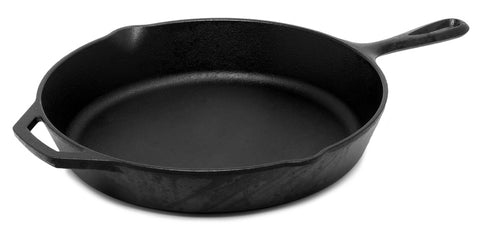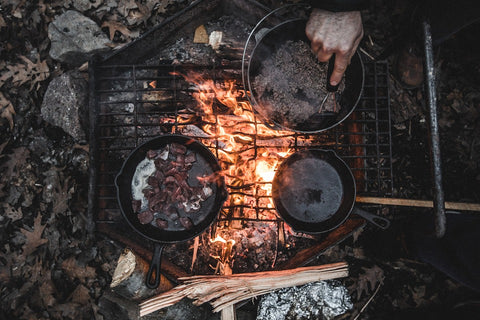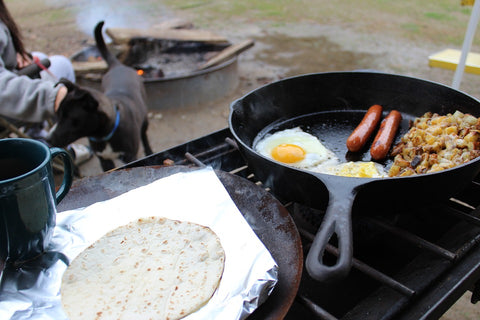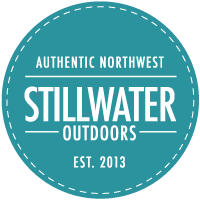Next to sleeping, eating is probably one of the most common reasons why people don't like camping. We get it. Cooking over a portable stove or campfire isn't exactly the same as tossing something in the microwave or baking in an oven. And we all agree that no one wants to eat burgers or hotdogs for every meal.
Thankfully, with a few well-chosen tools and a little know-how, you can master camping meals with ease. Our go-to camp cooking item? Cast iron.

Why Cast Iron?
Okay, so cast iron obviously isn't the right choice if you are going to be carrying all of your gear ten miles in to your campsite or in any other situation where weight of gear is important. But let's face it, many of us, especially beginners, are car campers. We drive up to our campsite, unload our gear, and usually bring far more than we ever need.
For the car campers out there, cast iron is a wonderful addition to your camping gear. It comes in a wide array of sizes and shapes, allowing you to select the perfect set for your needs. And although it does not heat evenly, it does hold heat well, so after a good pre-heat on the fire it will be ready to cook anything from fried eggs to roasted chicken. For those who have never used it before, we know how intimidating it can be, but don't let it scare you. After learning a few basic care tips, we're sure you'll be confident enough to try it during your next camping trip.

Seasoning
No, we're not suggesting that you sprinkle a little paprika on your cast iron. In this case, seasoning refers to a layer of polymerized oil that literally bonds to the metal of the pan. Most modern cast iron comes pre-seasoned, but a little extra never hurt.
The basic process to season a pan is to heat it for a long time (until the heat eventually spreads throughout the entire skillet leaving no obvious hot spots), rub it down with an oil, let it cool, and repeat. Specific directions will likely come with your cast iron when you buy it.
The best way to season your cast iron? Use it! Use it as often as possible. Every time you cook, that layer of seasoning builds up a little more. And though we don't recommend using your cast iron to beat off a bear or bash in a tent stake, you also don't have to treat it like fine china either. That layer of oil has literally bonded to the metal, which means that using metal utensils or a rough sponge won't hurt it.

Cleaning
For simple messes, try wiping it clean with a cloth or paper towel. Don't worry about removing all of the surface oils as they will help to protect the iron. If you have a few stubborn spots, a metal spatula may be able to scrape them away.
For the really difficult cooking residues, use soap and water. That's right, soap and water won't hurt your pan as long as you take a few precautionary measures afterward. Use soap and give it a scrub with the rough side of a sponge. When you are done, make sure to dry it thoroughly. We recommend reheating it on the stove to evaporate away the last of the moisture. Although soap won't remove the layer of seasoning, left-over water is an invitation for rust. Once the pan is good and hot, add some oil and rub it down (carefully so as not to burn yourself).
The type of oil matters! For those who use their cast iron regularly (every few days or so), almost any oil will do. But for anyone planning to store their cast iron for a while (a week, a month, etc.), only use heavily saturated fats like coconut oil, butter, or lard. They are more stable at room temperature and take longer to go rancid. And don't use a lot. Just enough to give it a little luster.
When you store it, be sure to keep the cast iron in a well ventilated area. Humid air can be just as dangerous as standing water given enough time.

Cooking
Although your cast iron can be used to cook just about anything, there are a few things to keep in mind. First, as we mentioned before, cast iron is horrible at heating evenly. Thankfully, there are ways around this. We recommend a good pre-heating at low heat. This allows the heat to spread slowly throughout the entirety of the pan. Just be sure to use a heating mitt or pad when grabbing the handle.
If your pan is properly seasoned, the food inside should never come in contact with the metal itself because of the layer of oil on the pan. That's the theory, but in reality there is always a chance of food coming in contact with metal. For that reason, we don't recommend long-simmering with highly acidic foods (like tomato sauce).
Uh-Oh ... Rust
For those who dig out their cast iron only to find that it has rusted while stored away, don't freak out and buy a new set. The pan can most likely be saved. First, deal with the rust. We recommend giving it a wipe with an oiled towel. If the rust doesn't wipe away, use some kosher salt as an abrasive. Still there? Keep working your way up to abrasive sponges and then #00 steel wool as a last resort.
Once the rust is removed, the pan should be dried thoroughly, first with a towel and then with heat. Once dry, wipe the spot with oil. Don't worry if the spot still looks dry. Place the pan back on the stove to heat on low for 10 minutes or so to "cook" the fat into place. Then, a good re-seasoning will make it good as new.
Now that you know the basics of cast iron care, your camping menu can be upgraded in ways you probably hadn't imagined. Peanut butter and jelly sandwiches? Not today. Another hot dog on a stick? No thanks. Bring on the breakfast hash, the roasted chicken, the steak fajitas. Remember, happy tummies means happy campers.
